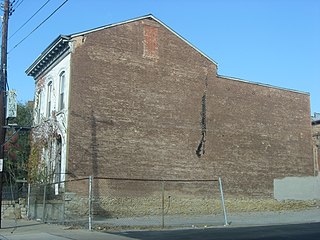
The Heinrich A. Rattermann House was a historic residence in the West End neighborhood of Cincinnati, Ohio, United States. Built in 1860, it was a brick building with a stone foundation and elements of iron and stone. It was the home of Heinrich Armin Rattermann from 1895 until his 1923 death. The most prominent German-American author in the history of the United States, Ratterman worked to solidify German-American culture; he sought to teach his compatriots their culture and produced a history of German Americans in Ohio.

The Benninghofen House is a historic residence in Hamilton, Ohio, United States. Constructed in the 1860s, this house has been named a historic site for its high-quality architecture. Once the home of prominent Hamilton residents, it has been converted into a museum.

Edgeton is a historic residence in the city of Hamilton, Ohio, United States. Built in the 1860s, its earliest residents were prominent businessmen in Hamilton, and it has been named a historic site.

The Rentschler House is a historic residence in the city of Hamilton, Ohio, United States. Constructed at the turn of the 20th century, it has been named a historic site.

The Loring Residence and Clinic was the first facility built to provide medical services to Valparaiso, Indiana. The residence has continued to provide for public service through its current use by the Valparaiso Woman's Club. Dr. Loring used his home as his medical office until his death in 1914. It was Loring's initial efforts that brought medical care to the county and provided for the first hospital. Although private, it became the county's first public hospital when Loring sold the building in 1906 to build his home and clinic.
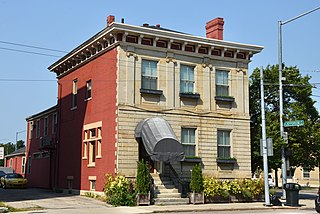
The James Brooks House is a historic house in downtown Dayton, Ohio, United States. Built in the 1830s and significantly modified later in the century, it was named a historic site in the 1970s.

The Isaac Pollack House is a historic structure now located at 208 West Monument Avenue in Dayton, Ohio, United States. Built in 1876, this Second Empire house was originally home to the family of Isaac Pollack, a prominent Dayton businessman involved in the liqueur trade. The walls are composed of a mixture of stone and brick with some wooden elements, resting on a stone foundation and covered with a slate roof.

The Samuel N. Brown House is a historic residence in southern Dayton, Ohio, United States. Constructed in the 1870s for a prominent industrialist, it has been used for commercial purposes since the 1920s, and it has been named a historic site.

The Dayton Fire Department Station No. 16 was a historic fire station on the near east side of Dayton, Ohio, United States. An architectural landmark constructed in the early twentieth century, it was named a historic site seventy years after being built, but it is no longer extant.

The Rudolph Pretzinger House is a historic residence in southern Dayton, Ohio, United States. Constructed in the late nineteenth century for a prominent local pharmacist, it now abuts a city hospital, but it has been named a historic site.

The Graphic Arts Building is a historic commercial building on the edge of downtown Dayton, Ohio, United States. Built in the 1920s, it long housed the publishing house of a Protestant denomination, and it has been named a historic site.
Center Street Historic District is a historic district in Ashland, Ohio, United States. Placed on the National Register of Historic Places in 1976 with a boundary increase that took place in 1992, Center Street features Victorian homes built in the late 19th and early 20th centuries. The district is established between Town Creek and Vernon Avenue on the east side of Center Street and between the theater and Morgan Avenue on the west side. Once known as Huron Road, Center Street runs current with Ohio State Route 511 and Ohio State Route 60, which travels the entire length of Ohio. The Center Street Historic District Association is the homeowners' association for the district.
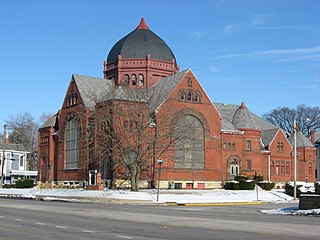
Third Presbyterian Church is a historic former Presbyterian church building in Springfield, Ohio, United States. A Romanesque Revival building completed in 1894 along Limestone Street on the city's northern side, Third Presbyterian is one of the final buildings designed by prominent Springfield architect Charles A. Cregar.

The John H. Nichols House is a historic house in downtown Wapakoneta, Ohio, United States. Built in 1865, it is Wapakoneta's oldest example of the Greek Revival style of architecture. Among its leading features are a three-bay facade with a prominent gable, large entablature, and cornices under the roof, several large windows on the front and sides, and a trabeated entryway framed by several sidelights and a transom supported by two brackets.
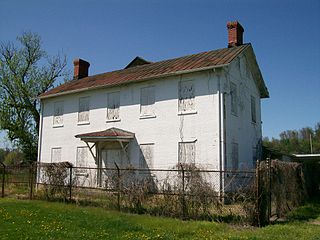
The Judge Joseph Barker House is a historic residence in southern Washington County, Ohio, United States. Located along State Route 7 southwest of the community of Newport, it is a brick structure with a roof of metal, a foundation of sandstone, and other elements of wood and metal. Constructed in 1832, it is a two-story rectangular building that sits atop an Ohio River bluff. Its floor plan is five bays wide, featuring a central entrance with a fanlight and sidelights.
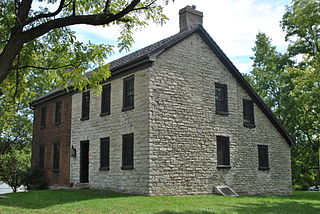
The Lewis Kemp House is a historic pioneer farmstead in the city of Dayton, Ohio, United States. Built for one of the area's earliest residents, it was a religious center in its first years, while later years saw its expansion to its present form. Now located among much newer houses, it is Dayton's oldest surviving residence, and it has been named a historic site.
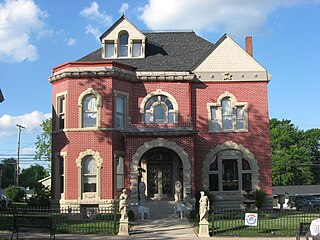
The Oram Nincehelser House is a historic residence in the village of Mechanicsburg, Ohio, United States. Built for a nineteenth-century local doctor, it has been named a historic site because of its distinctive architecture.

The John H. Clark House is a historic residence in the village of Mechanicsburg, Ohio, United States. Built during Mechanicsburg's most prosperous period, it was the home of a prominent local doctor, and it has been named a historic site because of its historic architecture.

The Gill–Morris Farm is a historic farmstead near the city of Circleville in Pickaway County, Ohio, United States. Established in the early nineteenth century, it has been named a historic site.
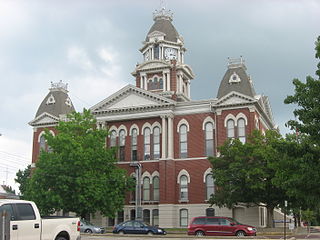
The Shelby County Courthouse is a government building in Shelbyville, the county seat of Shelby County, Illinois, United States. Completed in 1881, it is the third courthouse in the county's history.





















